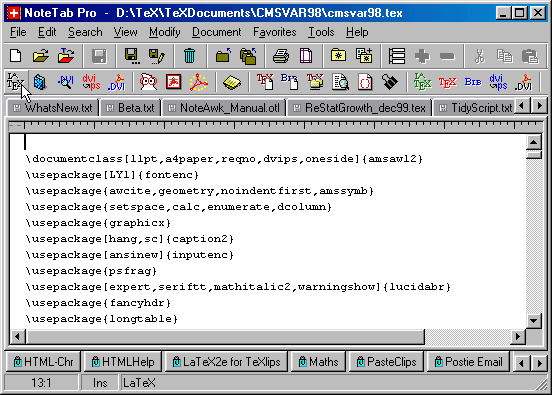
Contents
- TeXlips
- What you can do...
- Installation
- The Clips in TeXlips
- Directory Structure...
- What you need...
- Inverse Search
- Learn More...
- Legal Matters
- References
- Download TeXlips
- Feedback
- Structural VAR
- Warne's World
TeXlips - A MiKTeX GUI for NoteTab
The NoteTab clipbook library TeXlips has been designed to help the novice and the experienced MiKTeX user to run TeX and friends applications in a convenient and user friendly manner. The clip programming language in NoteTab is powerful and flexible enough to make this possible and hopefully TeXlips is able to fulfill its task of being the glue that binds the editor, the Windows operating system, and MiKTeX into a well integrated TeX system.
|
|
About TeX and TeXlips
As the name suggests, TeXlips deals with matters concerning TeX and its friends like the macro package LaTeX. The latter, named after Leslie Lamport, is a generic typesetting system that uses TeX (developed by Donald Knuth) as its formatting engine. The pronunciation of TeX is usually "teck", as in technology, because the X is actually the uppercase Greek letter chi (c). It's sometimes said in the TeX literature that the end of TeX should be pronounced like the end of Bach. This is rather unfortunate since few native English speakers know how to pronounce the late great composer's last name: Bach, being a German name, is pronounced with a deep "sch-ish" sound at the end. Sort of like when you've got something stuck in your throat... Alternatively, haggis and wee bitto dram may help you to pronounce "tech" like the Scots say Loch Lomond. In fact, in his TeXbook Knuth says that what I call the German/Scottish pronunciation of Tech is the correct one.
Still, TeXlips is obviously pronounced as "tecklips" since it runs TeX applications via Clips!
In case you didn't already know, the Greek word tec means art as well as technology. This mere fact is quite informative about what TeX is. In Don Knuth's words, TeX is a
Moreover, the displaced E is a reminder that TeX is about typesetting, not word processing. After all, who needs a word processor when there's NoteTab!
TeXlips gives you access to the MiKTeX implementation of TeX and friends through the NoteTab Pro and Std editors (the software also work in NoteTab Light 4.8 or later, but only from the clipbook). Most TeX and friends applications are launched from the command line. While this has many advantages (such as portability and speed) it also means that the applications are not very user friendly. For example, most programs support a large set of sometimes cryptic and often difficult to remember switches (or options). Although these are well documented it takes time to check the exact syntax whenever you need to to know how to set up a specific command line (unless you happen to have a photographic memory).
One of the main properties of a computer is that it has a (selective) photographic memory, or, in practise, at least something very close to it. It is therefore natural to let the computer keep track of all those launch features which are difficult to remember or simply too time consuming. For example, double clicking on an icon or a clipbook header is typically much easier and faster than writing
latex --src-specials c:\mytexdocs\newpaper\mydoc.tex
dvips -j0 -D 1200 -P cmz c:\mytexdocs\newpaper\mydoc.dvi
at the Windows run prompt. Naturally, you can use a batch file to speed things up or make use of the Windows Scripting Host to also allow for interactive script file launches. However, NoteTab's clip programming language has the advantage that it's integrated with the editor to help launch applications, edit and search text on the fly, and interact with the operating system. In addition, the language makes it easy to write code that's fast, interactive, flexible, and which can present alternatives to the user in an easy to understand manner. For instance, in the case of the DVIPS command line above the three switches can be presented in a window as:
- "Don't download fonts partially"
-j0, - "Set resolution to X dpi" (
-D X, where X is set to e.g. 1200 by the user), and - "Load config.EXT for DVIPS configuration and/or PostScript fonts" (
-P EXT, where EXT is selected by the user as e.g.cmz, corresponding to the fileconfig.cmzin thedvips\configsubdirectory to the mainTEXMFdirectory),
among the set of options supported by DVIPS. Moreover, if the user wishes to apply these switches (or any other switches) as the default for DVIPS, the code should be able to handle that.

TeXlips has been designed to help the novice and the experienced MiKTeX user to run TeX and friends applications in a convenient and user friendly manner. The clip programming language in NoteTab is powerful enough to make this possible and hopefully TeXlips is able to fulfill its task of being the glue that binds the editor, Windows, and MiKTeX into a well integrated TeX system.
Last Updated: September 26, 2003
Copyright © 1998-2003 Anders Warne